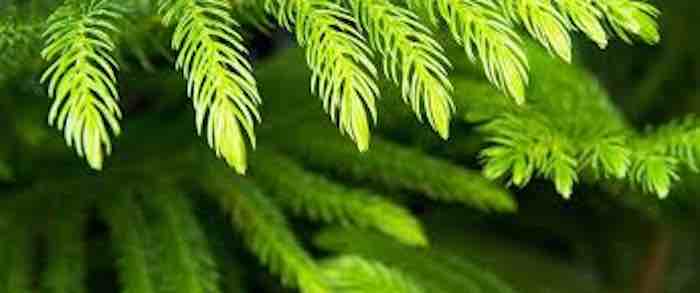
There are 126 species of true pine plus some three dozen experts can't make up their minds about. The Norfolk Island Pine is not one of these. In fact, botanically it is not a pine at all.
Instead it is an exceedingly popular houseplant, so much so that in Britain it is often sold under the name of 'House Pine.' In North America, tens of thousands are raised in Florida for the foliage plant trade. There they are named after their native home substituted towards December every year by 'Tropical Christmas Tree.' This is preferable since, unlike true pines, it will not tolerate cold temperatures, although its requirements are by no means tropical. Indeed, it will flourish in temperatures 21ºC days down to 13ºC at night.
The trick to maintaining as a long-visiting house guest is even moist soil without soaking or completely drying completely out, room to spread and, above all, filtered light--not too much or too little, either of which will cause the lower leaves and branches to drop.
Back in its insular habitat, this is a mighty tree, towering to 50 to 65 metres. Fortunately, in the home it will remain greatly abbreviated when grown in a modest container filled with an organic, open soil.
True to name though, it does originate from Norfolk Island, a former British penal colony, 877 miles east of mainland Australia, measuring just 13.4 square miles and supporting a population of something over 2.200. Today, Norfolk Island is part of Australia and its flag features a pine bordered by two green bands.
There are 20 species of
Araucaria recognized, all from the Southern Hemisphere, ranging from Brail through Argentina and Chile to New Guinea, Australia via Norfolk Island. While they are all coniferous evergreens, none belong to the true pines,
Pinus, but to their own family
Araucariaceae.
The strangest of these is the Monkey Puzzle Tree,
Araucaria araucana, named after the Araucani Indians who live where it grows. According to Mary and John Gribbin (2008), it received its common name when a visitor to the gardens at Pencarrow, Sir William Molesworth's garden in Cornwall, commented that the outward pointing spikes of the leaves would make a real puzzle for any monkey that tried to climb it. Ah, but here's the real puzzle: there are no monkeys in central and southern Chile, its native habitat.
 There are 126 species of true pine plus some three dozen experts can't make up their minds about. The Norfolk Island Pine is not one of these. In fact, botanically it is not a pine at all.
Instead it is an exceedingly popular houseplant, so much so that in Britain it is often sold under the name of 'House Pine.' In North America, tens of thousands are raised in Florida for the foliage plant trade. There they are named after their native home substituted towards December every year by 'Tropical Christmas Tree.' This is preferable since, unlike true pines, it will not tolerate cold temperatures, although its requirements are by no means tropical. Indeed, it will flourish in temperatures 21ºC days down to 13ºC at night.
There are 126 species of true pine plus some three dozen experts can't make up their minds about. The Norfolk Island Pine is not one of these. In fact, botanically it is not a pine at all.
Instead it is an exceedingly popular houseplant, so much so that in Britain it is often sold under the name of 'House Pine.' In North America, tens of thousands are raised in Florida for the foliage plant trade. There they are named after their native home substituted towards December every year by 'Tropical Christmas Tree.' This is preferable since, unlike true pines, it will not tolerate cold temperatures, although its requirements are by no means tropical. Indeed, it will flourish in temperatures 21ºC days down to 13ºC at night.